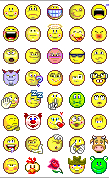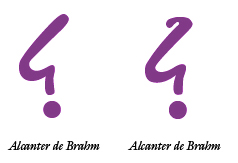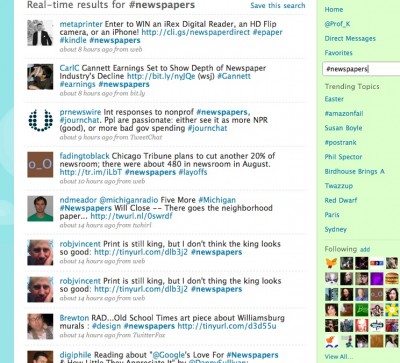So, as we become “scanners” of content in this Web 2.0 world, what will happen to language? As we use SMS and Twitter, bound by 140 characters, will the use of h@x0r and L33t-style words go beyond these contexts and into other modes of communications {such as e-mails and reports}?

Already, there’s a shorthand one needs to “decode” on the TV tickers for news, finance {above}, weather, and sports. Will technology reduce our written language to a lowest-common denominator? Will a linguistic Idiocracy set in, where those with good written communication skills die off, leaving the rest of us thumbing abbreviations and smileys on handhelds :-P?
Additionally, are we losing our capacity to read, in an “educated” citizen of society sense? Linguist, Naomi Baron studies technology as it relates to the evolution of language. She warns of the implications of this and offered this observation in a 2005 LA Times article::
“Has written culture recently taken a nose drive? These are the students who grew up on Spark Notes, the popular study guides. Many of this generation are aliterate — they know how to read but don’t choose to. And abridgment of texts is now taken to extremes, with episodes from micro-novels being sent as text messages on cell phones…
Will effortless random access erode our collective respect for writing as a logical, linear process? Such respect matters because it undergirds modern education, which is premised on thought, evidence and analysis rather than memorization and dogma. Reading successive pages and chapters teaches us how to follow a sustained line of reasoning.
If we approach the written word primarily through search-and-seizure rather than sustained encounter-and-contemplation, we risk losing a critical element of what it means to be an educated, literate society. “–“Killing the written word by snippets” (11/28/05) {Emphasis added}
What about those emoticons? Used to clarify meanings in text-based environments, are these shorthand shortcuts impoverishing our language?

Or, are they just transforming how we communicate? For example, you can be as blunt or brutal as possible, but if you follow it with a wink or a “smiley,” it plants tongue firmly in cheek. You get your digs in, but soften the blow. Is this playing in to the development of a passive-aggressive culture or at least a passive-aggressive written culture? F*** you! 😉
So, in order to be understood, will be be relying more and more on communication shortcuts {text shorthand, graphics, and/or even sound} not just in SMS texting and microblogging Tweets, but in other forms of everyday communication? I’ve seen people get frustrated with others because their irony or sarcasm wasn’t coming through. Allow me to reintroduce the irony mark, which has been around since the late 1800s::

Just in case someone might be overly-literal and might not get the fact that you’re being snarky, your bases are covered. Looking back on Baron’s quote, the big question for me has to do with the thinking process. I linger on terms like “logical” and “linear,” as I wonder how much of our communications are moving towards the “emotional” and “hypertextual.” The emoticon {or other shorthand symbol} and a jumbled mass of linked stream-of-consciousness utterances may be where we’re heading. I think the thought processes may be increasingly non-linear for more and more people and logic is taking a back seat to perlocutionary acts that try to elicit a response or some kind of action/reaction from others. This sounds a lot like advertising.
I offer this. Will everyday communication be a pastiche of a myriad of verbal/visual snippets? We scan through incredible amounts of information and gain meaning from “decoding” communications and constructing gestalts. The linear thought process of decoding and encoding meanings is subsumed by thought processes that cut and mix ideas.
Using Twitter as an example, take this Tweet by Clay Shirky.

In under 140 characters he communicates several key points and offers a hyperlink to the source, but without proper sentence structure. Nevertheless, we can get meaning from his Tweet:: (1) 3% of newspaper reading is done online, (2) cite of blog post on newspaper impressions for print/online, (3) assumption is that readers see 1/2 of the pages, (4) another assumption is that they read all articles, & (5) Clay’s quick analysis. We combine this information with other information {bricolage} for whatever purpose at hand. We can use web searches to get this information, On Twitter, we can look for other information on “newspapers,” using the hashtag:: #newspapers.

Walter Ong in his Orality & Literacy (1982) makes the distinctions between orality {spoken word} and literacy {print}. Part of me feels that SMS/texting and microblogging {Facebook “graffiti” & Tweeting} represent a hybrid mode, betwixt and between both orality and literacy. Literacy is assumed, but communications are taking on more of the characteristics of the spoken word. So, where is all of this heading? We will communicate in ways where we try to be understood, given the technological and temporal parameters. I think this will be increasingly distilled. The technology will evolve towards allowing people to cut and mix text, images, multimedia, sound, etc. Our use of language and how language enters our consciousness will evolve into new patterns.
These are musings and I welcome rebuttals. If you use harsh language, I’d prefer you soften the blow with an emoticon or two. 😉 🙂

Comments 24
Lorri Centineo — April 14, 2009
" The linear thought process of decoding and encoding meanings is subsumed by thought processes that cut and mix ideas. "
If I thought only a minute about this, I'd arrive at the conclusion that the cultivar of both is necessary, either concurrently or alternately. Perhaps this is the first time in history that both systems of thought will be equally honored, thus eradicating barriers to dissemination of information ...
You know....it takes me, a primarily non-linear, spatial thinker much longer to sequence, which makes me rather verbally inconvenienced, but not lacking in orality. (So, in that, I disagree with Ong...and so would have Winston Churchill...and John Irving, and...)
I'll be back as soon as I've done the visual hypertexty thingy completely in my head...and have translates that visual mass into , uuuhhh, words!!
andrew m. lindner — April 14, 2009
I was just thinking the other day about how thinking is disrupted by the Internet and came across two superb essays. Is Google Making Us Stupid? by Nicolas Carr particularly addresses the question of how the Internet has changed our very patterns of thought. Twilight of the Books by Caleb Crain considers how book reading is dying and how reading may become "an arcane hobby" of an elite class. Very disturbing thoughts.
meruprecht — April 14, 2009
really interesting post, ken.
this linguistic idiocracy... the connections between the transformations of language and those of reading: from reading to (merely) scanning also suggest changes in thought. the issue of a watered down language, of watered down reading also imply watered down thinking: and that brings me back to your post of last month and to walter benjamin and the issue his speculations in "art in the age..." ultimately lead to: distraction...
so my question is more of a judith butler question (or maybe a d&g question? ?? ??) than it is a benjamin question: how do we turn these evolvements into humanizing, radical possibilities rather than allowing them to become the "destruction" benjamin theorizes? (what does he say? oh yes it is the epigraph for my first post on blogger: http://mollyponderstheuniverse.blogspot.com/2008/04/blonde-bombshelling-and-other.html)
...anyhow, haven't even started my 2nd cup of java and you've got me thinking -- thanks for kickstarting my thinking-writing for the day! ... oh and, of course: :-)
rkatclu — April 14, 2009
QFT.
ellemac — April 14, 2009
Confession #1: This blog was too long for me to read. Is there any way you could possibly... twitterfy it?
Confession #2: I had to Google "QTF". (I thought it meant Quit Fucking Talking")
ellemac — April 14, 2009
Whoooops, sorry!
;)
rkatclu — April 14, 2009
Quoted For Truth.
Roughly equivalent to saying "word."
The internet equivalent of "Quit f***ing talking" would be STFU.
rkatclu — April 14, 2009
There is something to be said for brevity. At the same time, you can't shoehorn the thought of a Spinoza, Kant, or Hegel into 140 characters or less.
There are those who employ emoticons as a linguistic crutch. However, are emoticons really all that different from the various ways people qualify what they say in person (body language, explicit qualifications, informality, etc.)?
P.S. - Here are some links to Twitter humor/commentary:
(1) The Odyssey Twittered:
http://mashable.tumblr.com/post/93355398
(2) Newspapers Twittered:
http://www.guardian.co.uk/media/2009/apr/01/guardian-twitter-media-technology
(3) Nanoblogging:
http://www.youtube.com/watch?v=BeLZCy-_m3s
ellemac — April 15, 2009
hi rkatclu, thanks for the clarification (Google beat you to it, but nevertheless, appreciated). Interesting notion about emoticons not being all that different from body language or, I suppose facial expression, tone of voice, etc. My immediate response to that is, when people communicate online (not counting the use of webcams), they are doing so using the written word. Relying on emoticons to relay intent seems lazy to me (or, as you suggest, a crutch). Of course, this reaction is borne of a writer's vanity, and plenty of times conflicts might have been averted by just swallowing one's pride and inserting the tell-tale admission of irony... ;) I find them annoying as a reader, too, because it suggests my comprehension needs a handicap.
But as our culture of communication moves more and more into the online world, I'm thinking your point is more and more germane to the issues raised in Ken's blog. Mass communication is evolving and not everyone has the vocabulary and the subtlety to use words alone. And certainly the audience does not have the patience to read all the words necessary to communicate that which is more efficiently conveyed non-verbally. Witness my first comment. ;)
Lorri Centineo — April 17, 2009
Ken, you've used some the words that hit me where I live- bricolage, gestalt(en), and pastiche...
I have a lot of issues with Professor Baron's article because assumptions are made that can be hashed to bits, assumptions that are inimitably sequential, perhaps vertically narrow, when our world is not.
She writes:
"Will effortless random access erode our collective respect for writing as a logical, linear process?"
May I ask 'whose' collective respect? That collective may be a vast minority, and one that doesn't include the respect of dozens of well known and honored dyslexic writers, authors, poets, inventors, scientists, and artists.
And is the intent of a literate society to control, mete out information in a manner that is not natural for huge chunks of the population to absorb? Perhaps the 'effortless random access' evolving methods of communication are more natural for many people, and I also see that as a good thing. Shouldn't the masses choose for themselves? Or is that threatening to those who are more comfortable with closure in communicative efforts?
She continues with: "Such respect matters because it undergirds modern education, which is premised on thought, evidence and analysis rather than memorization and dogma. Reading successive pages and chapters teaches us how to follow a sustained line of reasoning."
But I go with this by Albert Einstein:
"It is a very grave mistake to think that the enjoyment of seeing and searching can be promoted by means of coercion and a sense of duty. To the contrary, I believe that it would be possible to rob even a healthy beast of prey of its voraciousness, if it were possible, with the aid of a whip, to force the beast to devour continuously, even when not hungry - especially if the food, handed out under such coercion, were to be selected accordingly."
Of course, Einstein was a man who was a systems thinker whose learning was based on gestalt. He's on a very long list that is typically ignored because there are so many on it who found sequential written language confining, confounding, and utterly inconvenient.
The purpose of language is to communicate. I hope we don't forget that. I think you're right in implying that the bits and chunks and graphics and videos will allow more people access to practical information, 'snippets' that will trigger creativity in those looking for that piece that fits into a schema, and opportunity for all to problem solve using the varied skills of a world population.
But that's the political piece, isn't it? The way we use language is frightfully political. We've forgotten how strict rules regarding the written word have not, even in recent history, served to promote equity... only the kind of equity where diversity is fine if you learn to do things 'my way.'
And I also finally see some intermingling of information from many sides of the imposed boxes. I read several articles/abstracts this week based on one piece of research that were interpreted in/for four different fields...four fields that approach the same issues from different directions with varying vocabulary and never do they meet. But now...those who want or need to can analyze and glean and mix and think and spin again. One giant step forward....
Of course...and now I'll be quiet.
http://www.youtube. com/watch? v=6gmP4nk0EOE
Molly — April 17, 2009
More often than not, getting a decent grade in classes requires nothing more than taking the massive amounts of information presented in the book(s), lectures, notes, homework, etc and condensing the important information that will likely be on the test. (also recommended is choosing from that information to tailor to what the professor wants.) I think this is one of the most important skills I have learned from my 14 years in educational systems and it is extremely helpful in my daily life. However, the act of doing this ourselves may be on the decline. Ryan's link to the newspaper that is going to ONLY twitter articles is a topic I am rather torn on. I can honestly say that I would probably get more out of reading those 140 word articles than the information that I received today while reading a newspaper the old fashioned way at lunch. On the other hand, if I weren't able to read a newspaper and know how to tell the important information from the filler, I would be on a much lower intellectual position. Will we see the effects of Idiocracy in the future? Not likely. Will we put less value on deep intellectual concepts? Probably. And if you missed the other link Ryan put up I encourage you to check it out, I'm thinking of sending it to my high school English teacher.
The Odyssey Twittered:
http://mashable.tumblr.com/post/93355398
p.s. :)
Yeraldy — April 18, 2009
Perhaps there will still be a fine line between language used in academia and the internet. I cannot imagine a world where professors and academic journals use shortened words and smileys. The language we use on the internet is different that what we use when we are in an academic state. Yes, the formality of language online has changed but I think that we still have a line for casual mode of language. I hope to always have a more serious and formal language when I am learning because the shortened version of English makes things more informal and harder to take seriously.
Jasoene Bentil — April 19, 2009
Such lax standards of how language is being used causes words and there meanings to lose the power and the strength of the language. Not to say that casual language cannot be used amongst friends but even when watching such news as CNN at time the language can be more casual then formal. They are the news and viable such for information they should place higher standards on language. Since it is becoming more and more readily accepted to have lower standards when it comes to languages newscasters are following suit when they should be the ones upholding the standards.
Kris W — April 19, 2009
To me the casual language of texting and twittering is a part of the spoken word, not the written.However I do think that constantly writing in such a casual language impacts people more then we think. Several times I have caught myself typing "u" instead of "you" however at a second look I catch it. But as long as people can separate the written from the casual it shouldn't be a problem. Furthermore, smiley's do lead to a more brutal and aggressive use of the language in my opinion.
Brent — April 20, 2009
I don't feel the need to be overly critical of how language and communicating is evolving over the internet and social networks. The internet as a whole is a tool that reduces barriers to, and improves the efficiency of communication. It's only natural that communications within a highly efficient network would follow and build upon that nature.
Kenneth M. Kambara — April 20, 2009
As any followers of this post {or blog} can attest, I am horrible at responding to comments. I did want to offer this article by Nick Carr, Is Google Making Us Stupid? When I saw the article the first time, I didn't give it much thought. Now, upon further review, I'm sure reading that article made me more stupid.
I take exception to his stance that privileges "reading" as a normative mode, as opposed to speaking or other modalities, and I wish psychologists would study people in cultures of orality. "Deep reading" presupposes a certain type of linear logic that may disenfranchise those who think in alternative patterns. Of course, many educators don't like this idea, as they feel students should be uniform bricks, not irregular stones. Bricks that don't wear denim.
Hannah Schenck — April 20, 2009
Language, whether written or oral, is the most powerful form of communication. It comes in an assortment of ethnicities, backgrounds and histories while still remaining relatively universal. Author Marilyn Kinsella declares there are 2 components to the value of language in storytelling that combine to allow the listener to be present within that story. One uses the general outline, then beefs it up with a particular time and place. Some of the most revered storytellers are those that capitalize on all that language has to offer - Nitzche, Tolstoy, and Dostoevsky to name a few. I would love to see a twittered version of “Daybreak” have the same effect when stripped down to the bare essentials. The evolution of mass Twitter and SMS use cheapens the meaning and depth behind that language. I’m surprised by how many major news networks are using Twitter – I wonder whether this is to boost ratings by engaging in what’s popular, or because it really is effective. Twitter may be the reformed way of headlining, but I see it as an easier way to take news out of context and cut every speech down to ridiculous sound bites. Having said that, I also believe that in regards to conversation stimulation, these methods can prove effective. Limited to 140 characters, we are forced to quickly determine our main point, rather than undergoing pages of roundabout research.
Evan Clark — April 20, 2009
This is just a step in the evolution of our language. Instant Messaging services such as AIM were created for direct instant communication much like talking to someone face to face. The difference is we need to take that spoken word and put it into a computer and send it on it's way as soon as possible in order for the communication to stay instant and not feel slow like early email. A younger generation will always adapt language in their own unique way and this generation has just adapted it to communicate over this new medium. Does that mean all written communication of bound ot change for ever. No. But it does make way for a new set of slang. We still have old english even though it is no longer the norm. Could this be the future norm, possibly but not likely. Written communication has only strengthened sing the rise of the internet. Until written text is obsolete we have proper english and this new internet slang.
Mike Young — April 20, 2009
Technology today is made to relay information, opinions, news, etc… as fast, easy, and sort as it can. Yes, language is changing in some form, but there is a distinct difference from posting a tweet or sending a SMS to writing an essay or an article for a paper. In a fast paced society it becomes more and more apparent that the quicker you can express yourself the better off you are. I personally don’t want to read a 4 paragraph essay on my friend’s day, but would rather just see “today was a good day.” But reading a friends SMS, status, or tweet is very different then when I want to read about a new public policy, news, or leisure. When I want to read that I do not want short and sweet, I want well defined ideas and conclusions giving me a complete understanding of what is going on.
I guess when it come down to it I would have to say yes language is changing, but language will not change as a whole. Certain aspects of our lives and communication will be shortened to 140 characters, but there will always be a place for “educational” communication and reading.
ThickCulture » Whither Twitter, Where are You Taking Us? — June 18, 2009
[...] in April, we had a lively discussion here on Twitter and language. I recently saw that the dictionary team at the Oxford University Press is on top of the sitch. [...]
In Praise of Sardoodledom | RethinkEducation — December 3, 2012
[...] concerns abound regarding the effects of social media on communication, I worry that there is a growing acceptance of the condensing of language in general (a concern [...]
Simon Higgins — November 28, 2014
The world is not getting better at the moment. :-)
In Praise of Sardoodledom | Rethink Education — July 22, 2015
[…] concerns abound regarding the effects of social media on communication, I worry that there is a growing acceptance of the condensing of language in general (a concern […]
Wtf is up with Twitter? Smh. | english214rocks — March 21, 2016
[…] https://thesocietypages.org/thickculture/2009/04/14/oh-twitter-what-will-become-of-our-language/ […]